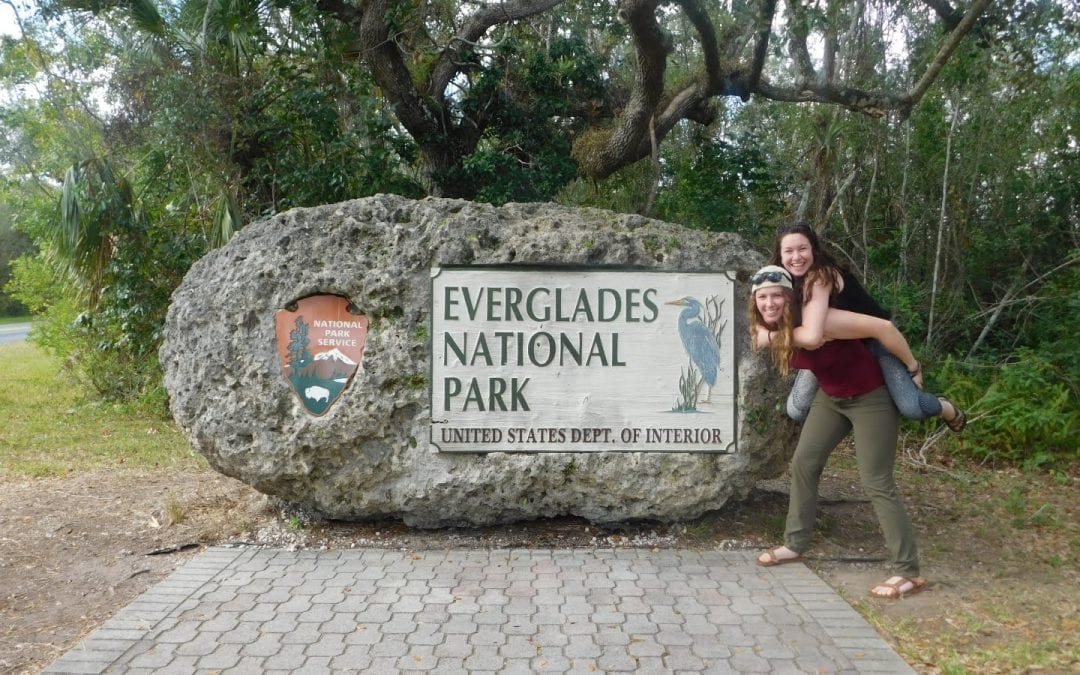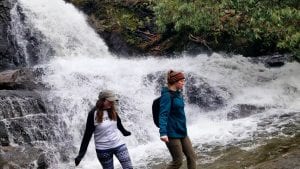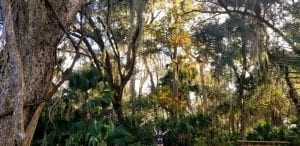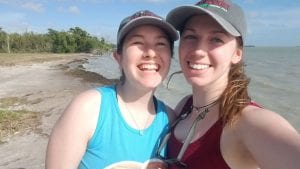By Katherine Gale
♦ ♦ ♦
“You live first, and then you write about it later.”
― Spencer Bucolo
♦ ♦ ♦
It’s 4:00am and my alarm sings me to consciousness. The sheer force of excitement lifts off the veil of exhaustion as I rise out of bed and turn on the light. With every step of my morning routine I dampen the nag of my mediocre 2 hours of sleep. It’s hard to quiet a mind for rest when it’s trying to plan out the next few weeks of roadway and skyline. With a somewhat giddy pace, I throw my belongings together and dedicate the rest of my first hour of the day to catching Ariel up to me in her morning routine. By 5:15, we close the car doors and drive into the darkness of the tail end of night.
I look at the estimated arrival time on my GPS, “I can’t believe in just 4 hours we’ll be at Shenandoah National Park.”
“I know, we’ll get there before noon!”
Our car/mobile hotel races down the highway. We cross the wide flat state of Pennsylvania, watching the suburbs turn to farm fields, cars turn to horses and buggies, and the darkness turn into the golden hour. We admire the frosty grass on rolling hills that the light of morning reveals to us. The rivers give foggy haze to the morning chill. When the sun finally emerges from behind the hilly eastern horizon, our eyes turn to the road signs and license plates around us. Before we know it, we jump states from Pennsylvania to Maryland, then West Virginia on to Virginia. Once we finally gain an understanding of where the GPS has taken us, tall blue silhouettes fill the Western horizon.
“Ariel, quit staring at your phone and look at what’s in front of you!”
We watch as hazy blue mountains wall us in, and before we know it we arrive at the northern entrance of Skyline drive. I’d be lying if I said that “Take Me Home Country Roads” by John Denver wasn’t on replay in my head this entire time. We journeyed more than a hundred miles over, through, and around mountain ridges.
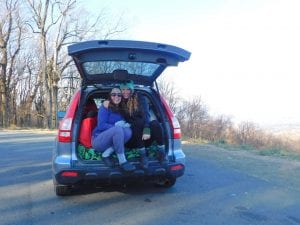
The sound of rain drops pounding on the windshield of our “hotel” for the night starts our next morning before our alarms can. We say goodbye to the Virginia rest stop where we took up residence last night and head for Asheville, North Carolina. We were expecting an uneventful drive through the rain as we rolled through southwestern Virginia, that was until we crossed into Tennessee.
The reason behind the name “Smoky Mountains” became very clear to us as we both noticed tall gray peaks begin to poke out of the clouds. Our task of driving transformed from a dreary chore to a privilege. Our eyes scanned the mountain walls on either side of the highway. Our jaws dropped as the clouds progressed in their departure from the mountain tops, sinking down into the valleys.
With the world transforming around us, we could no longer remain in the metal prison that was our car, we needed to fully embrace this transforming horizon. I say to Ariel, “Let’s try to find some place we can pull over to get some photos of these mountains”, and immediately after these words leave my mouth, we pass a “Scenic Overlook” pull-off on the left. I quickly bang a U-turn and make my way to the overlook.
Rain pours down, low-lying clouds blow quickly through the mountain foothills, and not a single other vehicle ventures to check out this overlook, just us two crazy New Yorkers. With our cameras tucked beneath our rain gear, we venture up the most poorly constructed concrete path ever made. Carefully traversing the steep highway-side hill, we find the gravel covered square that rests at the top as the highest overlook point.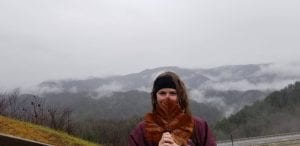 We take a moment to watch the clouds dance across the horizon and transform our view by the minute. Once our hair becomes completely drenched with rain drops, we decide it’s time to return to our metal hotel on wheels. A giant sycamore leaf catches my eye and becomes our third travel companion.
We take a moment to watch the clouds dance across the horizon and transform our view by the minute. Once our hair becomes completely drenched with rain drops, we decide it’s time to return to our metal hotel on wheels. A giant sycamore leaf catches my eye and becomes our third travel companion.
We realize as we continue our drive to Asheville that we haven’t really interacted with any locals of the south yet. When I had planned this trip, I did so with the goal of being open minded to knocking out my preconceived notions about “The South”, while also exploring the different cultures of places that I had never experienced before. So far our only engagement with the south was either through a windshield or a camera lens.
We arrive in Asheville a little earlier than expected. Our purpose for adding this stop to our trip is so that I could visit a friend and have her show us around her hometown—an easy means of engagement with southern culture via a familiar tour guide. We drive around Asheville and explore a little before our designated meet-up time with the city’s native, Autumn. As we wind through roundabouts and populated streets, we notice that there is something unique about this city. Unlike most cities we’ve encountered in the northeast, this one seems to have integrated the culture and feel of the mountains around it; with hiking and nature themed businesses, sculptures, and decor around every corner. We pick up Autumn shortly after our first encounter with Asheville, and she takes on a journey through southern culture and food. Autumn first educates us on southern fast food, and then brings us to a Paul Smith’s College alumni-owned second hand gear store. We buy some new outdoor recreation goodies and then navigate through flooded North Carolina streets. We part ways and head for Gatlinburg, Tennessee; Autumn leaves us with some advice for traversing the south,
“If the GPS tells you to get off the highway and take some backroads, DON’T DO IT. They will be super sketchy and definitely not worth it.”
We begin our two hour journey to Gatlinburg, being kept on our toes by the wild backcountry highway. To our left there is a 6 foot tall concrete wall, to the right there are endless tall rocky cliffs and no shoulders. Continuous lines of box trucks wall us in against the center divider. There is very little wiggle room here, so my worry about growing tired on this commute quickly fades away as the highway demands hyperattentive driving. The mountains of Tennessee welcome us through long, poorly lit tunnels. My GPS releases me from the highway onto backroads. We cross a bridge into a pitch black forest on a road with no lines. As the trees swallow us in, we lose sight of street lights and any other vehicles, and Autumn’s last words of advice ring through my mind. “Oh my god, Ariel, this is what Autumn was talking about! She told us that the GPS would try to take us down these roads and that we shouldn’t do it” I say, Ariel anxiously responds with an “Oh my god! What do we do!?”. I ask her if we have any cell reception, and to no surprise there is none to be found. We decide to commit to the adventure of following these roads— besides, we were less than an hour away from Gatlinburg and had more than enough gas, so there was no risk.
We finished traversing the backroads; the one major downside of taking this rural route instead of the highway is a lack of passing lanes. As a result, Ariel gets to listen to 45 minutes of me screaming profanity in response to a lack of sleep and a slow meandering SUV with Georgia plates in front of us. Suddenly the dark forest becomes illumined by decorative holiday figures lined with christmas lights on either side of the road. The crumbling trailers and rusty pickup trucks become gaudy tourist attractions crowded by an infinite amount of pedestrians. Ariel and I groan at the sign of all this light, color, and civilization as we have been sheltered by forests and farmland up until this point. We head to the adjacent town and take up residence in a Walmart parking lot for the night.
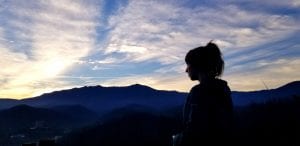 Every single day there is a sunrise. I usually witness the sunrise once, maybe twice a year. My daily life doesn’t incorporate sunrises, not like it does sunsets. As we crawled out of the car to start our morning, the sunrise greeted us. Streams of pink light stretching out from dusty blue mountain silhouettes embrace our squinty-eyed morning gaze. We realize that the darkness of last night hid from us the walls of the tall mountain bowl that we were sitting in. I am accustomed to mountains, my ideal place of residency, but these mountains have a magnitude that took me by surprise. I have hiked amongst some of the tallest mountains in the world, and stared down Himalayan peaks that cut through the sky, and still, the smokey mountains of Tennessee brought awe to my eyes. Maybe it is the backlight of the morning sun that is giving them this power, but either way, I can feel nothing but joy as I drive in their direction.
Every single day there is a sunrise. I usually witness the sunrise once, maybe twice a year. My daily life doesn’t incorporate sunrises, not like it does sunsets. As we crawled out of the car to start our morning, the sunrise greeted us. Streams of pink light stretching out from dusty blue mountain silhouettes embrace our squinty-eyed morning gaze. We realize that the darkness of last night hid from us the walls of the tall mountain bowl that we were sitting in. I am accustomed to mountains, my ideal place of residency, but these mountains have a magnitude that took me by surprise. I have hiked amongst some of the tallest mountains in the world, and stared down Himalayan peaks that cut through the sky, and still, the smokey mountains of Tennessee brought awe to my eyes. Maybe it is the backlight of the morning sun that is giving them this power, but either way, I can feel nothing but joy as I drive in their direction.
We spend our morning exploring half-washed away trails with crumbling pavement, surrounded by a warm blanket of humidity laid down by vibrant rhododendrons adorning the mountainside understory. After a little over a mile of rhododendrons, ridges, and mountain views, we reach Laurel Falls. Something Autumn said to Ariel and I back in Asheville pops into my mind, “When you’re in Tennessee make sure you check out the rivers. Mountains you can see in other places, but the rivers in Tennessee are like no other. I can’t really explain why, but you guys will see.”
And I did see. I see a powerful river fueled by runoff from yesterday’s rain. I see it roar through the valley of these mountains, it’s echo penetrating through even the densest patches of rhododendrons, until it can be heard on every portion of the trail.
We begin our 6 hour drive to Lumpkin, Georgia. The mountains dissipate instantly within our first hour of travelling due south. The flat, f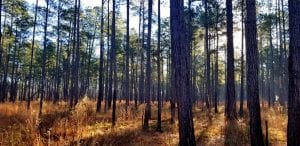 ar-stretched land removes my sense of security felt during our first two days of adventure. For the first time on this trip, we lose the slight sense of home that we felt in the mountains. However, the eerie feeling of not belonging is quickly replaced by the excitement of all that is new. The flat horizon quickly fills with walls of pin-straight southern pine trees. Our eyes search the roadsides for the trophy species that both of us scientists have made our goal to see during this southern excursion. For Ariel, it is the illusive armadillo, and for myself, the majestic live oak. Darkness quickly takes away our ability to search the roadsides.
ar-stretched land removes my sense of security felt during our first two days of adventure. For the first time on this trip, we lose the slight sense of home that we felt in the mountains. However, the eerie feeling of not belonging is quickly replaced by the excitement of all that is new. The flat horizon quickly fills with walls of pin-straight southern pine trees. Our eyes search the roadsides for the trophy species that both of us scientists have made our goal to see during this southern excursion. For Ariel, it is the illusive armadillo, and for myself, the majestic live oak. Darkness quickly takes away our ability to search the roadsides.
When we reach Lumpkin, Georgia, we pull onto a bright red sandy dirt road, to our left we read a sign that says “Gut Pile”, and to our right we see a sign for a rifle range. We quickly realize that we are definitely in the deep south, and that we are also quite literally in the middle of nowhere. We find a Wildlife Management Area with a few acres open to public camping that we call home for the night.
In the morning, impenetrable fog holds our line of sight hostage. We drive to a nearby canyon. Unlike the canyons out west that were carved out over millions of years by the elements, this Georgia canyon used to be agricultural land. The land was so over-farmed that the deep-set roots holding the earth 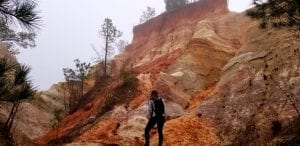 in place were no longer present, leading to large carved out walls of vibrant soil, colored by minerals and stories of the underground. Itching to get to an actual living structure where we can take a much-needed shower, we hit the road after about 2 hours of hiking and make a b-line for Davenport, Florida. The first hour of driving yielded a trance-like state of near-silence as our surroundings took us in. Small towns with more baptist churches than homes entrance us. Cotton fields with no end, plantations of wide spreading peach and pecan trees mesmerize us with their pristine spacing. The land like art, gently framed with the stagnant low lying haze that stuck around from this morning.
in place were no longer present, leading to large carved out walls of vibrant soil, colored by minerals and stories of the underground. Itching to get to an actual living structure where we can take a much-needed shower, we hit the road after about 2 hours of hiking and make a b-line for Davenport, Florida. The first hour of driving yielded a trance-like state of near-silence as our surroundings took us in. Small towns with more baptist churches than homes entrance us. Cotton fields with no end, plantations of wide spreading peach and pecan trees mesmerize us with their pristine spacing. The land like art, gently framed with the stagnant low lying haze that stuck around from this morning.
By noon the concept of “December” is ripped away from us. Full sunshine, 100% humidity, and 90 degrees Fahrenheit hug away the winter cold from which we came. The nostalgia of summertime fills the car. With windows down and our sunglasses on, large smiles set in. We tear down straight roads through pine plantations, searching the roadside flood channels for reptile inhabitants. Squeaks of joy escape our mouths when the first sight of spanish moss arrives; it sways in the sunshine and warm breeze as it hangs off the mighty branches of live oaks, my trophy species.
Florida traffic rips away our smiles, and we both reach the point of “I just want to take a damn shower”
We spend the next few days basking in the perks of running water and a king sized bed, like the anoles around the screened in pool area were basking in the sun. We take a few day trips, run into a friend, share a few drinks, and fully recover from the car camping experience. Just in time to get right back into it.
At 5:00am we pack all our car camping essentials back into my Honda. In this moment, we have an extra feeling of excitement that wasn’t there during our other morning take-offs. “Today is the day, the purpose of our whole trip! Today we are actually going to see the Everglades!”, I say to Ariel as the sunlight ignites the dusty grey sky into a pink fire. In high school we used to talk about how we wanted to see the Everglades before they were gone. So the underlying feeling that accompanied our drive across Florida this morning was that of fulfillment, that we were about to stick to our words that were said over 5 years ago.
We spend the first four hours of our day getting a full taste of Florida. Slowly we remove ourselves from the central cities, the retirement communities, and the beachfront resort areas. We enter the wide flat farm country, the land of the locals. We gaze at far stretches of starkly flat wetlands. We watch as they turn into plantations of tropical fruit and nut trees. It began to feel like we were in a different country, so distinctive from the rest of the parts of the U.S. where I have been before. We both acknowledge the two eerie feelings brought about by this land. The first being that fact that you can clearly tell that this is a place that hurricanes hammer down on the hardest; there were no structures built higher than one story and no trees peaked higher than 15 ft. The second is the fact that we know that within the next century this land will likely be underwater.
Before we know it we reach the main gate of the Everglades National Park. The barren rural farm country is suddenly buzzing with tourist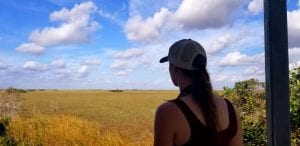 traffic as we become surrounded by cars with license plates from all over the U.S. Trying to shake off the irritance of the influx of park visitors, we focus in on the one of a kind ecosystems in front of us. We gaze at surprisingly crystal clear waters, full of unique and colorful fish. We watch large gators take naps in the sunshine. We read about the trees and plants hardy enough to last through hurricanes and forest fires, and still hold the title of some of the most diverse forests in the continental United States. We then take to the road, to continue our journey all the way through the park. We want to see everything. The road is long, flat, and straight, and it leads all the way to the ocean’s edge. I speed past the “Elevation: 3 Feet” signs and try to take everything in.
traffic as we become surrounded by cars with license plates from all over the U.S. Trying to shake off the irritance of the influx of park visitors, we focus in on the one of a kind ecosystems in front of us. We gaze at surprisingly crystal clear waters, full of unique and colorful fish. We watch large gators take naps in the sunshine. We read about the trees and plants hardy enough to last through hurricanes and forest fires, and still hold the title of some of the most diverse forests in the continental United States. We then take to the road, to continue our journey all the way through the park. We want to see everything. The road is long, flat, and straight, and it leads all the way to the ocean’s edge. I speed past the “Elevation: 3 Feet” signs and try to take everything in.
In that moment, with the sun warming our skin, the windows down, and the humid breeze dancing with our hair, I felt a sense of peace. It was a comfort that brought me back in time to summer days in the Hudson Valley; the exciting times when I, with my new driver’s license, would pick up Ariel to take her on adventures. We’d tear down country roads, winding through expansive farm hills, judging the excessively large “country homes” of New York City weekenders, that would never be filled with the love and values like that of a small-town family. I was brought back to the times when we’d drive down back roads that we’ve never explored before, where every unnecessary mile we drove was worth far more than the cost of the gas that was burned.
An empty feeling creeps into my core as I realize those days are gone. Spending 4 years in suburbia has drained the small-town values out of the girl from Carpenter Hill, my Ariel. I cherish those days like no other. And I will cherish this day, because in small moments, I have gotten her back. My mind loud, our voices quiet, we tear down State Highway 9336 toward the Flamingo Visitor Center. The wind fills our ears and the smell of salt in the air begins to draw our attention to the mangrove marshland surrounding us.
“We must be getting real close to the ocean now” I say.
We drive past hikers, kayakers, campers, photographers, and boaters as we head straight for the oceanfront. When we reach the end of the road, the swarms of tourists fade out and we find an empty beach area. We stick our toes in the white waters, clouded with limestone. We look through the rocks for shells, and forget about every little stress and worry that has plagued our lives for the last few months, years, or even our morning commute to the tip of Florida.
When my life is graced with moments like this, I know but one thing, this will not be our last.

